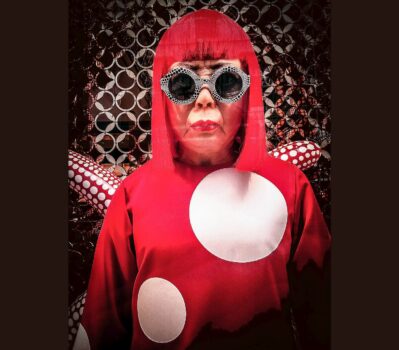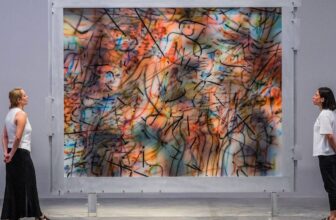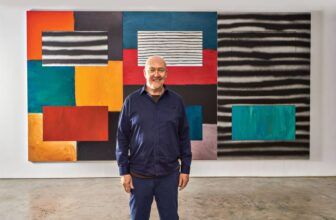Yayoi Kusama Famous Paintings
A Polka-Dotted Beginning
In the soft light of Matsumoto, Japan, 1929, Yayoi Kusama was born into a conservative merchant family. From an early age, she experienced vivid hallucinations, fields of flowers talking to her, skies filled with endless dots, pumpkins whispering their shapes into her imagination. For most people, such visions might have been frightening. For Kusama, they became the heartbeat of her art.
“I translate hallucinations and obsessional images into paintings and sculptures,” she once said. Her art was not an escape from reality, it was the magnification of it.
By the late 1950s, a young Kusama, armed with determination and an extraordinary visual language, left Japan for the United States. There, she immersed herself in New York City’s avant-garde art scene, rubbing shoulders with Andy Warhol, Claes Oldenburg, and Donald Judd. While others saw her as eccentric, she saw herself as a chronicler of infinity.
Yayoi Kusama Famous Paintings
Kusama’s career spans decades and mediums, painting, sculpture, performance, and installation, but her paintings remain the core of her legacy. Here are some of her most famous works:
1. Infinity Net Series (1958–present)
Kusama began painting Infinity Nets shortly after moving to New York. These massive canvases feature obsessive, looping brushstrokes, tiny nets that seem to spread infinitely. The hypnotic repetition mirrored her mental state, where she experienced a sense of losing herself into patterns.
2. Pumpkin Series
Pumpkins became one of her earliest and most enduring motifs. She saw them as “humble and humorous,” a comforting presence in her hallucinations. Her pumpkin paintings often feature bold yellow and black polka dots, creating a cheerful yet surreal presence.
3. My Eternal Soul Series (2009–present)
A late-career explosion of creativity, this series consists of hundreds of vividly colored canvases filled with biomorphic shapes, eyes, and bold patterns. Each painting is uniquely titled, such as I Want to Keep Living Forever or Walking on the Sea of Death.
4. Accumulation Series
Though also existing in sculpture form, Kusama’s Accumulation works in painting showcase obsessive layering of repeated forms, phallus-like shapes, dots, or other organic symbols, reflecting both her personal anxieties and her desire to overwhelm the viewer’s senses.
5. Love Forever Series
Black and white paintings with kaleidoscopic patterns, dense and almost psychedelic. These works often feature repeating eyes and interconnected forms, suggesting both surveillance and interconnectedness.
What Was Yayoi Kusama Known For?
Kusama is known for:
Polka dots and repetition , Her signature visual language transforms dots into cosmic portals.
Infinity concepts , Through pattern, mirrors, and repetition, she creates a sense of boundless space.
Avant-garde performance art , In the ’60s, she staged public “happenings” that combined nudity, body painting, and anti-war protests.
Mental health transparency , Kusama has openly discussed her psychiatric struggles, spending decades voluntarily living in a Tokyo mental health hospital while producing art daily in a nearby studio.
Immersive installations , While not paintings, her Infinity Mirror Rooms have become global sensations, drawing huge museum crowds.
Her work is a rare balance of deeply personal expression and universal visual impact, whether you know her biography or not, her dots and colors speak directly to human perception.
How Does Yayoi Kusama Make Her Paintings?
Kusama’s process is meticulous and meditative:
Concept and Vision
She begins with an idea rooted in her inner visions. Sometimes it comes from a hallucination, other times from an obsessive urge to repeat a form until it fills her consciousness.Base Layer
She often applies a monochrome base, white, black, or a bright solid color, depending on the mood of the work.Repetitive Mark-Making
Using fine brushes, she paints small, precise dots, loops, or biomorphic shapes. This repetition can take weeks or months per canvas.Layering
She builds up layers to create depth, ensuring the dots seem to float or recede, creating optical vibrations.Color Play
In later works, Kusama became bolder with color, juxtaposing complementary tones to heighten visual energy.Final Coating
Many works are finished with protective varnish to preserve vibrancy, especially for museum display.
Kusama has said painting is her way of “obliterating” herself, losing her individuality in an ocean of repeated marks. The act becomes both therapy and compulsion.
How Many Paintings Does Yayoi Kusama Have?
Exact numbers are difficult to pinpoint because she continues to create prolifically, but estimates suggest:
Over 1,000 large-scale paintings in her career.
The My Eternal Soul series alone contains over 800 canvases created since 2009.
Dozens of early works from her New York years remain in museum collections.
If one counts smaller works, works on paper, and private commissions, her total painted output could exceed several thousand pieces.
What Art Style Is Yayoi Kusama Associated With?
Kusama defies easy categorization, but art historians connect her to several movements:
Pop Art , Her bright colors and repetition influenced and interacted with Pop Art in the ’60s.
Minimalism , The meditative repetition in Infinity Nets aligns with minimalist aesthetics.
Abstract Expressionism , Early in her career, she worked within large-scale, all-over abstraction.
Psychedelic Art , Her hallucinatory imagery and vivid colors resonate with psychedelic visuals.
Feminist Art , Her use of organic, bodily forms and her performance art challenged gender norms.
Above all, she is seen as a Singular Visionary, her work emerging from personal necessity rather than strict adherence to a school.
What Materials Does Yayoi Kusama Use?
For paintings, Kusama commonly uses:
Acrylic paint , Allows for bold, flat color and fast drying, essential for building layers.
Canvas , Ranging from intimate to mural-scale.
Ink and marker , For her black-and-white line-based works.
Gesso , Prepares the surface for painting.
Varnish , Protects and enhances colors.
Brushes of varying sizes , From fine detail brushes to broader applicators.
While her sculptures often use fiberglass, metal, and soft textiles, her paintings remain rooted in traditional materials, transformed by obsessive process.
How Much Do Yayoi Kusama Paintings Cost?
The market for Kusama’s paintings has skyrocketed in the past two decades:
Smaller works on paper: $100,000 – $500,000
Mid-size paintings: $1 million – $5 million
Large iconic works (Infinity Nets, early Pumpkin paintings): $7 million – $10+ million
Auction records: In 2021, her painting Untitled (Nets) sold for over $10 million, setting a new personal record.
Her popularity with both private collectors and major museums drives prices ever higher, making her one of the most commercially successful living artists.
Where Are Yayoi Kusama’s Paintings Located?
Kusama’s paintings are held in prestigious collections worldwide:
Japan
Yayoi Kusama Museum, Tokyo , Houses rotating exhibitions of her paintings, sculptures, and archives.
National Museum of Modern Art, Tokyo.
United States
Museum of Modern Art (MoMA), New York.
Whitney Museum of American Art, New York.
Hirshhorn Museum, Washington D.C.
Europe
Tate Modern, London.
Centre Pompidou, Paris.
Stedelijk Museum, Amsterdam.
Australia
Queensland Art Gallery.
Museum of Contemporary Art, Sydney.
Private Collections
Numerous collectors hold early works and rare paintings in private estates.
Many of her pieces also tour internationally for special retrospectives, meaning a Kusama painting could appear in your local museum temporarily before returning to a permanent collection elsewhere.
The Story of a Painting’s Journey
To understand Kusama’s art, imagine standing in front of one of her Infinity Nets. At first, you see simple loops. Step closer and the perfection of her hand-painted forms astonishes you, each mark slightly different, each curve made by a steady, human hand. Step back again, and the loops dissolve into a shimmering surface that seems to vibrate. You are no longer looking at paint on canvas, you are peering into infinity.
The magic lies in this duality: her paintings are both intensely personal, born from her inner world, and universally accessible. Even without knowing her biography, viewers sense they are encountering something beyond decoration: a visual diary of a mind that refuses boundaries.
Yayoi Kusama’s Legacy in Dots
Yayoi Kusama’s story is not one of easy triumph. She has battled mental illness, financial hardship, and gender discrimination. Yet through each decade, she has transformed adversity into visual poetry.
Her paintings are more than objects, they are experiences, each dot a heartbeat in her lifelong rhythm. She once said, “I want to live forever in my art.” Looking at her works, one feels she already has.
From the humble pumpkin to the boundless net, from early Japanese watercolors to million-dollar auction sales, Kusama has made painting an act of persistence and infinity. And somewhere, in her Tokyo studio, she is likely sitting before another blank canvas, brush in hand, beginning again, dot by dot.




